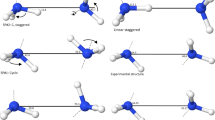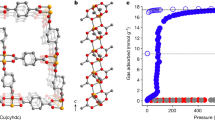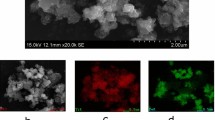Abstract
IN 1933 Cleeton and Williams1 observed a broad absorption band in ammonia at atmospheric pressure in the region of 1 cm. wave-length ; this is attributed to the 'inversion' of the pyramidal ammonia molecule which occurs when the nitrogen atom swings through the plane of the three hydrogen atoms. We have re-examined this phenomenon using a new technique, and have found that, as the pressure is reduced from 600 mm. mercury to 0.2 mm., so that the frequency of the collisions becomes small compared with the frequency of the radiation, an elaborate system of absorption lines appears.
This is a preview of subscription content, access via your institution
Access options
Subscribe to this journal
Receive 51 print issues and online access
$199.00 per year
only $3.90 per issue
Buy this article
- Purchase on SpringerLink
- Instant access to full article PDF
Prices may be subject to local taxes which are calculated during checkout
Similar content being viewed by others
References
Cleeton and Williams, Phys. Rev., 45, 234 (1934).
Hsi-yin Sheng, Barker and Dennison, Phys. Rev., 60, 786 (1941).
Manning, J. Chem. Phys., 3, 136 (1935).
Author information
Authors and Affiliations
Rights and permissions
About this article
Cite this article
BLEANEY, B., PENROSE, R. Ammonia Spectrum in the 1 cm. Wave-length Region. Nature 157, 339–340 (1946). https://doi.org/10.1038/157339c0
Issue date:
DOI: https://doi.org/10.1038/157339c0
This article is cited by
-
A microwave spectroscope for the 1,25 cm wave region
Il Nuovo Cimento (1952)
-
Lo Spettro di inversione di NH3
Il Nuovo Cimento (1950)



